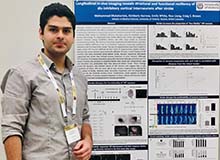Research published in Nature Communications shows manipulating dis-inhibitory neurons could improve stroke recovery
Stroke often impairs sensory and motor functions that disrupt everyday activities and independent living. Although some patients experience partial recovery in the weeks and months that follow a stroke, the majority are left with permanent disability.
One explanation for this limited recovery is that stroke leads to a long-lasting dampening of brain activity, rendering part of the brain abnormally quiet. Therefore, one potential way to improve recovery would be through restoring brain excitability and neural activity. The Brown Lab specifically tested the idea that manipulating a certain population of inhibitory neurons that inhibit other inhibitory neurons (called “dis-inhibitory” neurons) could be helpful for improving stroke recovery.
As detailed in the resulting paper, which was published in Nature Communications on October 20, 2021, the lab first discovered that increasing activity within these dis-inhibitory neurons could amplify weakened brain responses to sensory stimulation. “To use an analogy, this is like turning up the volume on a speaker so the brain can properly detect and act up incoming sensory stimuli,” says Dr. Craig Brown. The research also showed daily injections of a drug that selectively activates these dis-inhibitory circuits helped test models recover the use of limbs.

To better understand how stroke and the drug treatment affected these neurons, the paper’s first author Mohammad Motaharinia (MSc student, Neuroscience Graduate Program, Brown Lab - pictured left) took on the difficult task of imaging activity patterns within the same neurons before and in the weeks following a stroke. He made several remarkable findings. First, he found that activity patterns were highly variable, even within this one specific population of dis-inhibitory neurons. Some neurons were highly active and involved in sensory processing, whereas others seemed quite inactive and indifferent.
He also found the highly active neurons were the most disrupted by stroke and showed the greatest recovery. Contrary to initial expectations, less-active neurons did not become more active after stroke. This argues against the widely held idea that stroke recovery is mediated by recruiting “new” neural circuits. Instead, recovery appears to be mediated by reactivating those circuits that were highly active and involved before stroke.
Lastly, Mohammad found the drug therapy that improved stroke recovery prevented the disruption of function within the highly active neurons. Collectively, these findings reveal that enhancing activity within a specific a sub-population of inhibitory neurons can significantly boost recovery from stroke.
